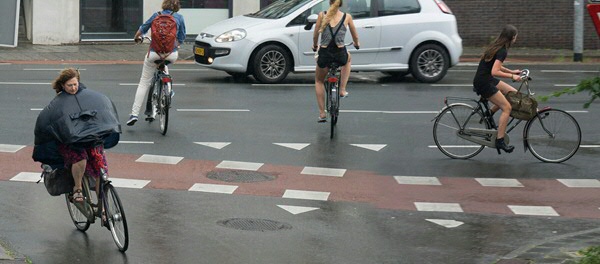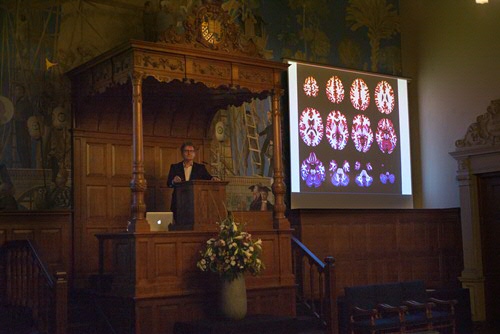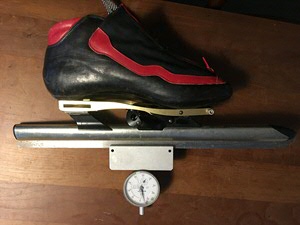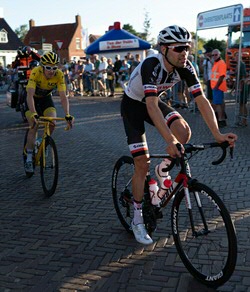From fish jaws to patented leg prothesis
Movement scientist and biophysicist Bert Otten continues to be amazed and inspired by the relationship between technology and life around him. The scientist and inventor in him – and not forgetting the photographer and the cyclist – are reaping the rewards.
Text by Fenneke Colstee-Wieringa - Photos by Bert Otten / www.kalons.nl

he photo is entitled “Sudden Rain”. A woman’s billowing poncho, her sandals planted firmly on the pedals. Ankle boots, flip flops and trainers worn by other cyclists and a worryingly robust car at the same T-junction. The photo is an ode to dynamism, technology and balancing acts. This is nothing more than a scene from the life of movement scientist Bert Otten. He has taken a photo for his blog every day for almost ten years. In addition to his collection of cameras, he has the talent and – as befits a biologist – a nose for observation.
Homo universalis

‘I don’t take the world for granted’ is a key motto for this homo universalis, who, in addition to being a successful researcher and photographer, is an inventor and advisor to elite athletes. He has even celebrated his own victories as an amateur cyclist. In his role as professor by special appointment of Neuromechanics and Prosthetics at the University of Groningen/UMCG, all these elements come together perfectly. Otten also likes to talk about his work. ‘There’s a reason I was voted Lecturer of the Year; I really can explain everything.’ That might sounds like bragging, because his field is very technical; it’s all about the transfer of forces and motions by means of hinges, levers, axles and so on. But he can indeed explain a lot. And perhaps that’s because he approaches technology from a biological perspective.
Biophysics
Fireflies, a cat, a path, a flying heron, beautiful landscapes, skies and starry nights and a giant grasshopper rising from tarmac – you’ll never get bored on his photo blog. Many of Otten’s photos testify to his love of nature, but the then Biology student also wanted to know how that insect’s eye, leg or wing worked. He ended up studying Biophysics in Leiden, where he received his doctorate with honours for his research on the intriguing jaws and sight of cichlids. His thesis on these fish won a national prize for originality.
Explaining science
He still gets enjoyment from his PhD research: ‘Look, can you see that? That fish’s mouth is made up of lots of tiny rods. I recreated that system on the computer, in 3D. In those days – the eighties – that was completely new. I also encountered quite a lot of opposition. When I showed my computer animation – which jolted from slide to slide with a clunk – to one of my heroes, a professor, he said: ‘How strange. You can see how that fish moves, right? What is it you’re trying to do with the computer, again?’ That’s how I discovered just how important it is to be able to explain science, and how fantastic it is to teach people and raise awareness about science.

Clap skate
Anyway, once I was able to calculate and understand these jaw movements using the computer, I thought to myself: but then I can also use such a system of rods to slide a shoe on a skate, so that the foot not only takes off, but also rolls off. That’s how I invented a rolling clap skate, for which I have a patent. That’s also available on the market, but Viking, the sponsor of the Dutch speed skaters, doesn’t have the patent.’
Patent
Building on the cichlids’ jaw mechanism, which has been tried and tested for four million years, the movement scientist also developed a patented leg prosthesis, which, thanks to ingenious but simple-looking triangular connections – ‘See, that looks very similar to the fish jaws, doesn’t it? – offers more balance and stability. I let these mechanisms evolve on the computer in the same way the fish evolved in nature over millions of years. In both nature and your computer program, you need variety and selection. Then, in the end, you only end up with whatever works.’
Paraplegia
Otten appreciates the fact that his inventions really help people. For example, by developing ingenious systems for transferring forces on his computer, he also invented a trapeze bar that ‘doesn’t hang above a hospital bed blocking the TV’, but which, thanks to a rolling mechanism and heating pipes that were curved in Otten’s garage, allowed a man with a high spinal cord injury to pull himself upright in bed. For the first time in his life. ‘That man had tears in his eyes.’
Epke Zonderland
But, for him, the most important part of his work is to infect people with his enthusiasm. ‘And I’m good at it. If I’m feeling good, I know that I’ll have captured the attention of a lecture hall filled with 300 students within ten minutes. And that some of them will actually take some of it in.’
Otten is therefore a much sought-after speaker. For example, for the recent ‘Techtalks’ series that was launched at the University of Groningen, and which were organized by Studium Generale. And also for the radio and TV. Like the time he ended up on De Wereld Draait Door with his analysis of Epke Zonderland’s Olympic gold-winning horizontal bar routine. At the request of Rector Magnificus Elmer Sterken, Otten studied this performance. After four days of research, he was able to explain to UG student Zonderland and the rest of the Netherlands where the gymnast – when things almost went wrong –, by moving his thumb, had managed to bring his genius routine to a successful conclusion. For Otten, this revelation was ‘just’ a matter of good observation, scientific analysis and clear presentation.

Winning time trial
There is no denying that movement sciences can benefit elite athletes. During the University of Groningen’s most recent anniversary celebrations, Otten, in the presence of retiring Rector Magnificus Sterken, told the remarkable story of Dumoulin’s and Roglic’s time trials during the World Championships in Norway in 2017. Otten had calculated whether or not it would be beneficial to change bikes just before the final climb and, when asked by Primoz Roglic, he advised against doing so. But the Slovenian ignored his advice. Tom Dumoulin, in another team, had been given the opposite advice from his coach: change bikes for the climb. Intuitively, however, the Dutchman decided to try not to waste any time and to use the same bike for the entire time trial. And the strategy worked: Dumoulin, who outclassed everyone, won the time trial and the world championship. Otten watched on with satisfaction, but, as always, in amazement. Because that never goes away.
| Last modified: | 20 June 2019 3.34 p.m. |
More news
-
30 September 2025
Lieutenant General Elanor Boekholt-O’Sullivan awarded the Aletta Jacobs Prize 2026
The University of Groningen (UG) has awarded the Aletta Jacobs Prize 2026 to Elanor Boekholt-O’Sullivan, the first female lieutenant general in the Dutch armed forces. The prize will be presented on Friday 6 March 2026 by the Rector Magnificus of...
-
15 September 2025
Successful visit to the UG by Rector of Institut Teknologi Bandung
The Rector of Institut Teknologi Bandung (ITB), Prof Tatacipta Dirgantara, paid a 3-day visit to the UG.
-
04 July 2025
University of Groningen awards various prizes during Ceremony of Merits
The UG awarded different prizes to excellent researchers and students during the Ceremony of Merits on 4 July 2025.
